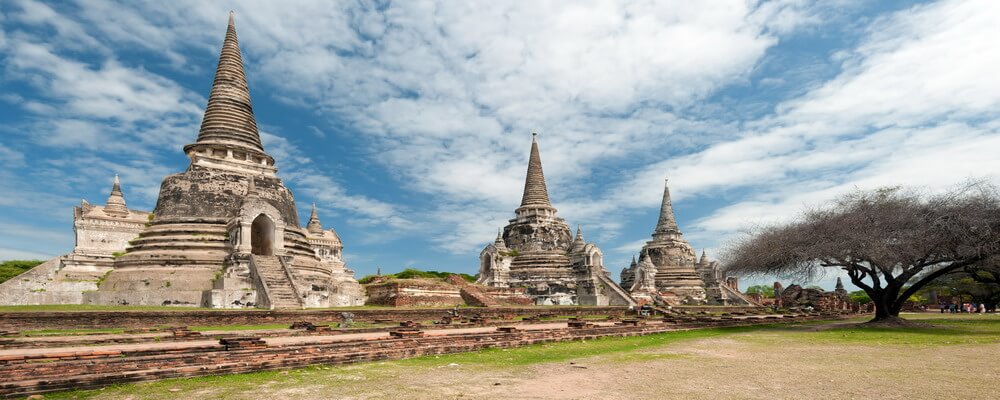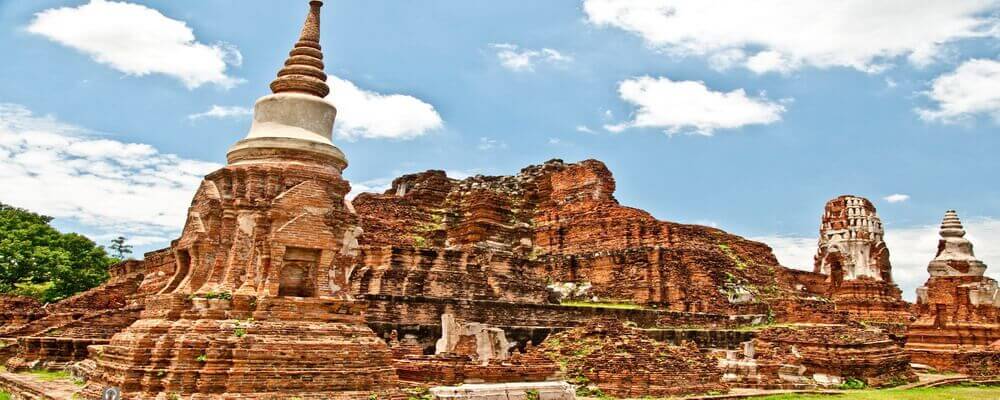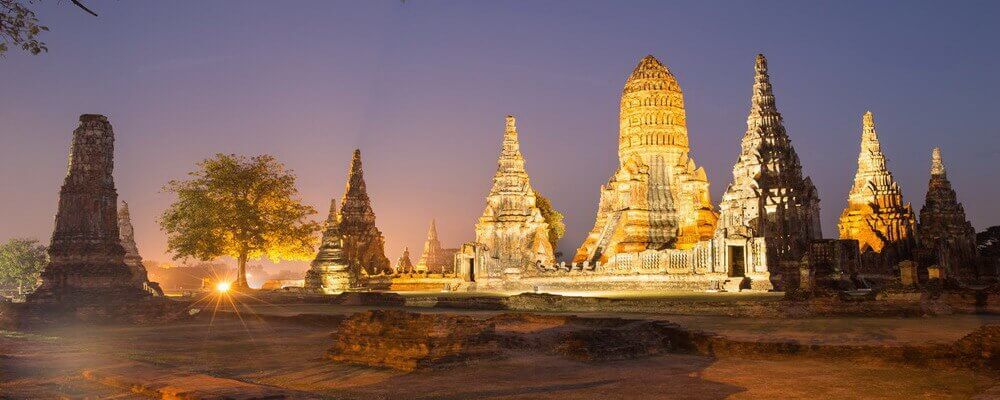 Ayutthaya Historical Park
Ayutthaya Historical Park
The Ayutthaya Historical Park contains the ruins of Phra Nakhon Si Ayutthaya, the ancient capital of Ayutthaya Kingdom. The city was founded in 1350 by King Ramathibodi I, who reigned at that time in the territory of Lopburi. Ayutthaya was built on a small island at the junction of three rivers: the Lopburi, Prasak and Chao Phraya. In 1351 the King made it the capital of his Kingdom. Ayutthaya Kingdom, with the next 35 Kings, dominated the most of Siam for over 400 years. The city prospered during the years arousing the greed of neighbouring Burma. The city suffered 23 sieges over its splendor, before being conquered and almost completely looted and destroyed on April 7th 1767. Two national heroes, General Taksin and Chao Phaya Chakri, drove out the Burmese invaders from the territories and gathered the country under the Chakri Dynasty. Phra Nakhon Si Ayutthaya never recovered from this looting. The capital was moved to Thonburi by King Taksin, who unified the country conquering the Lanna empire in the North, and founded the Kingdom of Siam. Phra Nakhon Si Ayutthaya was one of the most important cities of the time with over a million inhabitants. Its location halfway between China, India and Malaysia also made it an ideal port for trade. European vessels, Japanese and Chinese used Ayutthaya as a port of trade for teak wood, ivory, leather, and silk. Many of these merchants claimed that Ayutthaya was the most beautiful city they had ever seen, it became known by the nickname of the Venice of the East. In its heyday Ayutthaya had more than 1500 temples and 4000 statues, the Burmese army that defeated her in 1767 completely destroyed the city and its beautiful structures, decapitating statues to prove his power. In 1969 the Thai Fine Arts Department has started the renovation of the ruins, intensified since the site was declared a historical park in 1976. A part of the Ayutthaya Historical Park was declared a UNESCO World Heritage Site in 1991. Of the countless historical artifacts of Ayutthaya 95 sites on the island are now part of the UNESCO World Heritage. From these 67 are temples sites, of some buildings remain only the foundations of brick or accumulations brick yet to be restored.
Admission & opening hours: the access to some ruins in the Historical Park is free, open every day without time limits and without tickets. The main restored temples are open daily from 08:00 to 18:00, with tickets from 20 to 60 THB.
Getting around Park: once you get to Ayutthaya five bridges allow the access to the island, one to the west, one in the east and three to the north, where are most of the historical artifacts, a restricted area of 6 square kilometers at north of Somdet Phra Srinakarindra Park, a few minutes walk from one to another. For the temples outside island you can use the ferry services along the rivers, or simply cross the bridges again. An alternative way of moving is to rent a bike. There are several shops that rent bikes around the island, from 60 to 100 THB per day; to charterers you can also ask for a map of the park, usually free.Read More
Info
- Address: Tambon Pratuchai, Si Ayutthaya
- Telephone: +66 3524 6076
- Website: www.ayutthaya-history.com
Dinamic Map
Ayutthaya Historical Park Highlights
Wat Mahathat, which means Temple of the Great Relics in Thai, is located in the centre of Ayutthaya Historical Park. The Wat besides being the religious center symbolic of Ayutthaya, where the Buddha's relics were preserved, was the residence of the Supreme Patriarch, the leader of the Thai Buddhist monks. The temple was built during the early Ayutthaya period, 14th century A.D. The main Prang, the most important building of the temple, fell down the first time during the Ayutthaya period, restored collapsed again in 1911. Currently of the Prang remains only the foundation. One of the most recurring and disturbing photos of Ayutthaya is certainly the severed head of a statue of Buddha imprisoned in the branches of Banyan tree, a fig tree of India, located in Wat Mahathat. The sculpture of the Buddha's head is completely surrounded by tree branches, creating a unique show of its kind, probably the most famous of whole Ayutthaya. This area of ancient capital was brutally destroyed by the Burmese armed and many Buddha statues were beheaded.Read More
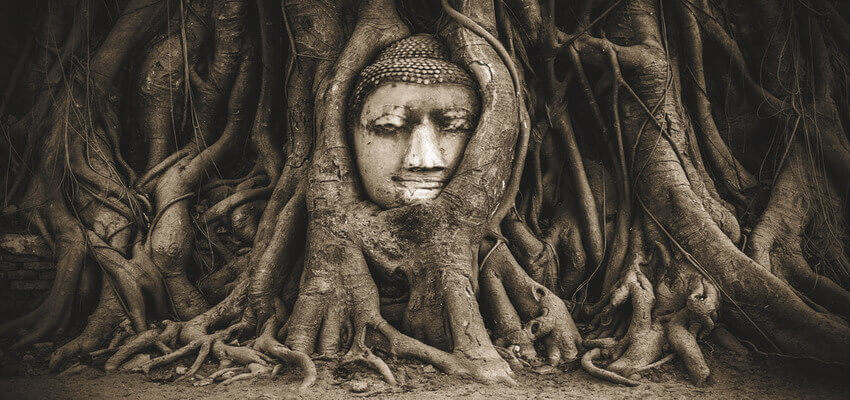
Wat Chai Watthanaram is a Buddhist temple, dating from the late Ayutthaya period, located on the south-western bank of the Chao Phraya River, outside the island. The temple was also destroyed during the Burmese looting, in 1767. The Wat Chai Watthanaram was built in 1630 by King Prasat Thong, in Khmer architectural style, to commemorate his mother's hometown and to celebrate his coronation. The Prang of central temple, representing of Mount Meru, is 35 meters high, and is surrounded by four smaller prangs. The whole building stands on a rectangular platform, and is surrounded by eight towers shaped chedi. In ancient times the towers were connected by a covered gallery to form a cross, with numerous side entrances and open inwards; of the original structure only the foundations of the pillars and the outer wall are still standing. Along the wall they are located the remains of 120 statues of Buddha in a sitting position, probably painted in black and gold, almost all beheaded during the plunder of Burmese. Outside of the passage to the east, along the river, was the Ubosot, the ordination hall of temple, of this edifice remained only the base. At north and south of Ubosot were two chedis, in which were kept the ashes of the King's mother. The Wat Chai Watthanaram was renovated, in part, in 1987 by the Fine Arts Department of Thailand, and now is one of the main attractions of Ayutthaya Historical Park.Read More
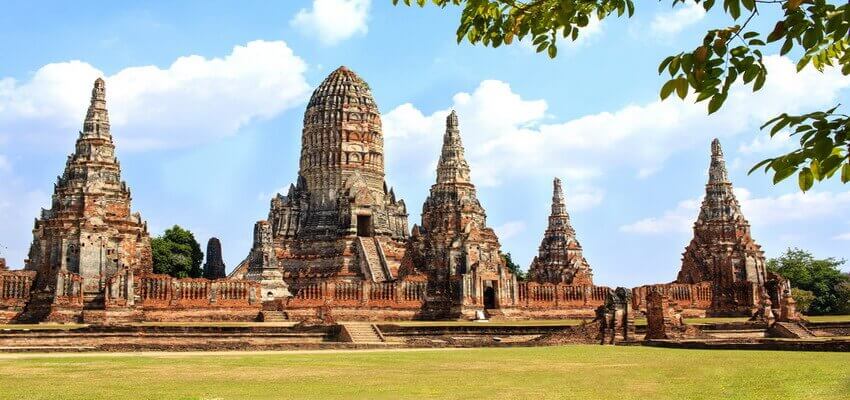
Wat Phra Si Sanphet, built in 1491, was the only Buddhist temple which was located within the complex of Grand Palace. The temple did not have resident monks, this was also the original idea of first kings of Chakri Dynasty, when they built the Wat Phra Kaew inside the Grand Palace in Bangkok. The monks were allowed on Royal invitation only for certain ceremonies. During the heyday of the Ayutthaya Kingdom was the largest and most beautiful temple in the capital, until the city was completely destroyed by the Burmese in 1767, and is served as a model for Temple of the Emerald Buddha in Bangkok. The most important feature of the temple were his three great Stupas, known as Chedis in Thailand. King Ramathibodi II built the first two in 1492 to preserve the ashes of his father, King Borom Trailokan , and his brother, the King Boroma Rachathirat III. The third Chedi was built in 1592 by King Borommaracha IV, and here were deposited the ashes of Ramathibodi II. The three Chedis were built in the classic style of Ceylon, bell-shaped. In 1499 Ramathibodi II ordered also to build a giant image of the Buddha to be installed in the Vihara Luang, the Royal Chapel of worship, within the Wat Si Sanphet. The huge statue it needs more than three years to complete. The statue called Phra Si Sanphet Dayan was 17 meters high, including the base 3.5 meters high and 8 meters wide. The core was made of bronze and weighed about 64 tons, the surface was covered with about 343 Kg of pure gold. When the Burmese conquered the capital of Ayutthaya Kingdom began a widespread destruction and looting of many temples and other buildings, including Wat Phra Si Sanphet, which was set on fire, the gold of his statues was melted and stolen. Completely damaged and abandoned only the few remaining structures help us to imagine the temple in its former glory. Of the original structure have remained the foundations and the three Chedis, which were in turn destroyed in the looting, but recovered by the restoration work, that began in 1956.Read More

The Chedi Phra Sri Suriyothai was constructed from the sixteenth ruler of Ayutthaya Kingdom, the King Somdet Phra Maha Chakkraphat, as a memorial to his consort, the Queen Somdet Phra Suriyothai, the first heroine of Siamese history. The Queen, who died February 3, 1549, has gone down in history for having sacrificed his life to save the consort during an invasion of Burmese. There is uncertainty about the historical origins of Queen Suriyothai, some sources speculate that it was a Princess of Phra Ruang Dynasty, which had ruled the former Sukhothai Kingdom. In 1549 the King of Burma Tabinshwehti invaded the Ayutthaya Kingdom. The vanguard of his army led by the Viceroy of Prome, Thado Dhammayaza, collided, on the outskirts of Ayutthaya, with the army led by King Maha Chakkraphat. The Queen and her daughter, the Princess Boromdhilok, worried about the fate of the King mingled among the troops, who were fighting on elephant back, concealing their identity beneath the armor. During duel between the King and Viceroy of Prome, the king's elephant had a panic attack and fled. The Queen, saw her consort succumb, interposed her elephant between the King and the Viceroy, fighting in turn but remaining killed by shots of sickle war, together with his daughter. The queen's body was transported to the city on a boat along the Chao Phraya River. King Maha Chakkraphat in his honor was a great ceremony of cremation and put the ashes of Queen Suriyothai in Suan Luang, the Royal Garden, which was then known as Wat Sop Sawan, in a chedi built in her honor. Wat Sop Sawan was lost over time due to a subsequent modernization of Ayutthaya. It was Rama V that looking the historical evidence of this fact found the remains of the chedi. The chedi was later appointed Chedi Phra Suriyothai by Rama VI in memory of the Queen Phra Suriyothai, the first woman heroine of Siam. The white and golden chedi was renovated in 1990 by Fine Arts Department. Now it's a beautiful memorial surrounded by manicured gardens. During the renovations we were found some ancient objects, such as a Buddha image in rock crystal white, a chedi replica, and a golden reliquary. These antiques are now preserved in the Chao Sam Phraya National Museum.Read More

Wat Lokaya Sutharam was a temple which was located in the center of the island area, about 800 meters from Wat Phra Mongkon Bophit. The temple was completely destroyed during the looting of the Burmese in 1767, of its structure were a few ruins, brick walls and piles of bricks, and a giant statue of the Reclining Buddha. The image, named Phra Bhuddhasaiyart, was inside the Viharn of the temple, which was completely destroyed. The impressive image of Buddha is 37 meters long and 8 meters high, and was built of brick and concrete in the Middle period of the Kingdom of Ayutthaya. The head is placed on a lotus flower, legs overlap exactly to show the equalized toes, a sign of enlightenment and beauty. The image was restored a first time in 1954 and again in 1989, and is the largest of the Reclining Buddha images that can be seen in Ayutthaya.Read More

Wat Ratchaburana was a beautiful Buddhist temple located just north of Wat Maha That, on the island area. The temple was built in 1424, on the orders of King Boroma Rachathirat II, on the site of the cremation of his two elder brothers. The complex of Wat Ratchaburana is being renovated, but still it gives an idea of the splendor of ancient Ayutthaya. Among the ruins are two beautiful towers, stone carved in Angkor style. These were built in memory of two brothers of the King, even their sons of King Intha Rachathirat, killed each other in a duel for succession to the throne. The temple's main Prang underwent restoration, and is now one of the most finest in the Ayutthaya Historical Park. Surrounded by four stupas Sri Lankan-style, inside you can be admired precious stucco with representations of Garuda, Nāga and other mythological creatures. Inside the main Prang there is also the crypt, which is accessed along a narrow staircase. In 1957 the temple's crypt was looted by robbers of a large number of Buddha images, models of boats and artifacts of gold. The thieves were later caught; over 100 kg of gold and more than 2,000 images and boats of inestimable value were recovered. The artifacts are now housed in the near Chao Sam Phraya Museum, along with other rare images of the Buddha, found in subsequent excavations.Read More

Wat Mongkhon Bophit was a temple which was located adjacent to Wat Phra Si Sanphet. The temple, probably built in 1538, was completely destroyed by fire and then collapsed during the destruction of capital by the Burmese in 1767. The building looked like the Grand Palace in Bangkok, but it was actually a temple Buddhist. What remains is a Viharn, completely restored in 1957, and named Viharn Phra Mongkhon Bophit. The peculiarity of this Viharn is not its architecture, but the huge gilded bronze statue of the Buddha which is inside, named Phra Mongkhon Bophit, one of largest in whole Thailand. The statue is 17 meters high, including a base high 4.5 meters, and a width of 9.55 meters. The Phra Mongkhon Bophit does not have a certain date. Historians provide a dating between the years 1448 and 1602. From historical evidence available it is known that the King Chairacha Thirat built the Wat Chi Chiang Sai, and a chedi, near a point of cremation. In 1538, in addition to these buildings, the King also ordered the merger of a Buddha image to be placed outside the temple. Phra Mongkhon Bophit was probably this merger. Tests more reliable report that in 1610 King Songtham ordered the construction of a Mandapa, a covered structure with a square base, to preserve the image known as Phra Mongkhon Bophit. During the reign of King Sua, from 1697 to 1706, lightning struck the Mandapa. The roof collapsed and fell on the statue beheaded. The King ordered to renovate the statue and the building, turning it into a Viharn. A second restoration of Viharn was accomplished during the reign of King Borommakot, from 1732 to 1758, a few years before being burned by the Burmese during their looting, in 1767. The modern restoration of the burned Viharn started in 1955, and was completed in 1957 by the Department of Fine Arts Thailand. In 1990 the Foundation Bophit Phra Mongkhon in Ayutthaya has asked to Department of Fine Arts cover the bronze statue with gold leaf. The work, once approved, are completed in 1992.Read More

Wat Phanan Choeng is located outside the island, at southeast near the confluence of the Pasak River and the Chao Phraya River, not far from Wat Yai Chai Mongkol. Throughout history it has been restored several times, the first times during the Ayutthaya period and later by the Chakri Dynasty, during the Kingdom of Siam. The present temple has thus a more modern form, which little resembles the original structure. Wat Choeng Phanan is one of the active temple in Ayutthaya, always full of faithful who come to worship a great image of Buddha, named Phra Chao Phanan Choeng. The statue, according to historical records, dating back to 1324, therefore 26 years before King U-Thong founded Ayutthaya Kingdom. At origin the Buddha image stood in the open space, the temple around was built later. The big statue is a representation of the Buddha in the posture of Subduing Mara, a classic in Thai culture. The image measuring 14,25 meters from knee to knee and 19 meters high, and is built of brick and mortar and covered with gilded stucco. It is one of the largest, oldest, beautiful and revered Buddha images of Thailand. The local people usually call it Luang Pho To, i.e. Great Reverend Father, Thai of Chinese origin call it Sum Pho Kong, which means Good Luck in Boating. The Viharn, the hall of worship and assembly, of temple contains other three Buddha images, in usual posture of Subduing Mara. Two images is assumed to date back to the Sukhothai period. The images were found covered with gilded stucco, probably masked to hide their value during the looting of the Burmese in 1767. In 1963, during a cleaning process, the filler came out revealing their melting metal. An image is in pure gold, 190 cm high and 145 cm wide, the second is constituted by an alloy of copper, silver and gold, and is 228 cm high and 170 cm wide. The third image, the largest in the centre between the other two, dates back to the Ayutthaya period, and is in stucco covered with gold, 256 cm high and 182 cm wide.Read More
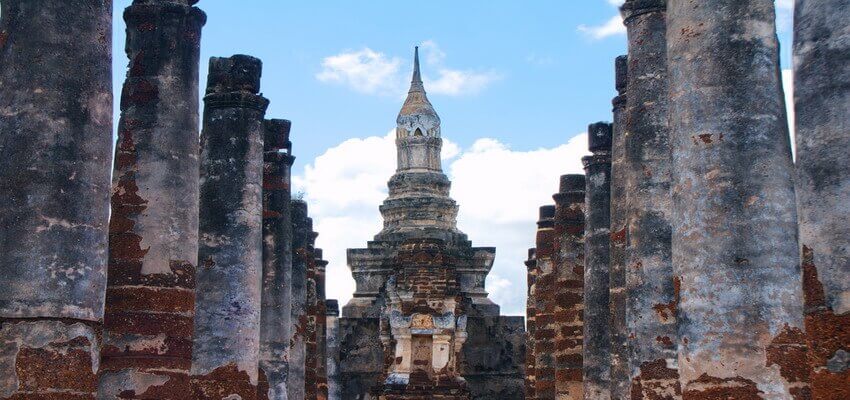
Wat Yai Chai Mongkol, or Mongkhon, is located outside the island area, near the southeast shore of the River Prasak. The temple is one of those who were found in the best conditions, one of the most beautiful and colorful of the entire area of Ayutthaya. The temple was built in 1357 by King U-Thong, Ramathibodi I, to accommodate the monks ordained by Patriarch Phra Wanratana Mahathera Burean. Originally the temple was named Wat Pakaew. The Patriarch, later, recommended to the King Naresuan the Great to build a large chedi inside it. The chedi was named Phra Chedi Chai Mongkol, known also as Phra Chedi Yai or the Great Pagoda. So the name of the temple was changed to Wat Yai Chaya Mongkol, which means the great monastery of the lucky win, in reference to a great victory of Siam people against the Burmese. The impressive structure is 62 meters high, and is made up of more than 28,000 tons of bricks. In the temple you can see several buildings in good state of preservation. Wihan Phraphutthasaiyat, the Vihara of Reclining Buddha, was built during the reign of King Naresuan the Great for worship and religious meditation real. The great image of the reclining Buddha inside was restored in 1965. The Phra Ubosot of the temple, the hall of orders, and the Vihara, the part monastic, are joined by a gallery along which there is a main stupa and several stupas satellite, all lined outside the gallery. Phra Chedi Chai Mongkol is the main chedi of the temple, exactly what built as a memorial of victory over King Maha Uparacha of Burma.Read More

During the heyday of Ayutthaya his Kings have built three Royal palaces on the island: the Grand Palace, the Chantra Kasem Palace and Wang Lang. Grand Palace was the first Royal Palace built in Ayutthaya, in 1350. The building was the residence of the Kings and was placed in strategic area near to the Northern city wall. The original buildings were likely constructed in wood. Today of the building, destroyed during the Burmese invasion in 1767, only the foundations and parts of some walls remain, visible near where is the ruin of Wat Sri Sanphet. The Grand Palace consisted of several buildings with different purposes, including a hall for Royal ceremonies, a hall to receive state visitors and, of course, a section dedicated to the Royal residence. A replica of the Grand Palace can be seen in the Ayutthaya Historical Study Center. Chantra Kasem Palace, usually known as Wang Na or Front Palace, was built in 1577 as a royal residence for the Crown Prince. The building was located to the east of the Grand Palace, on the north-eastern tip of the island. Wang Na consisted of a group of buildings, some traditional Thai and some European style. During the 17th century it was added a tower observatory for stargazing. Today the building is used as a museum for historical artifacts found of Ayutthaya period. Wang Lang, known as the Rear Palace, was built by King Maha Thammarachathirat as the Royal residence for one of His sons. The palace is placed in the south-west of island, on the east bank of the old Lopburi River, which during the 19th century became the bed of the Chao Phraya River. Later at the original building were added other buildings, used as a private residence for the other members of the Royal Family.Read More

 Get to Ayutthaya
Get to Ayutthaya
Getting there: Ayutthaya Historical Park is located on an island surrounded by the Chao Phraya, Pa Sak and Lopburi rivers, adjacent to the new town of Phra Nakhon Si Ayutthaya, 78 Km North of Bangkok. From Bangkok you can reach Park by bus, train, river boat or private car. Buses to Ayutthaya from capital leave from the Northern Mo Chit Terminal, every 15 minutes and arrive at Thanon Naresuan, about one Km at east of Park. The trip takes between 1½ to 2 hours; fare is 60 THB for 1st class, 35 THB for 2nd class. Trains to Ayutthaya depart from Bangkok’s Hua Lamphong Station at least once per hour. The trip takes between 1½ to 2 hours; fare is 66 THB for 1st class, 35 THB for 2nd class and 20 THB for 3rd class. The Ayutthaya railway station is located just east of the island. Several companies offer Chao Phraya river cruises from Bangkok to Ayutthaya. A one-day trip all inclusive, forward path by bus back with river boat, including a stop at the Bang Pa-In summer palace near Ayutthaya will cost about 2,200 THB.
Path Bangkok - Ayutthaya - Historical Park: for those who have self-owned car, or hire, the easy way from Bangkok is follow one of the many Expressway or Tollway towards North, choose the most suitable for your location in the capital as the Sri Rat Expressway or Utra Phimuk Tollway if you are in the center or Thanon Kanchanaphisek if you are at Savarnabhumi Airport, all converge in the Highway 32, Phahonyothin Road, that leading to Si Ayutthaya, about 78 km in total.
We Sugest
Find the best Hotel in Thailand at "Lowest Price"









